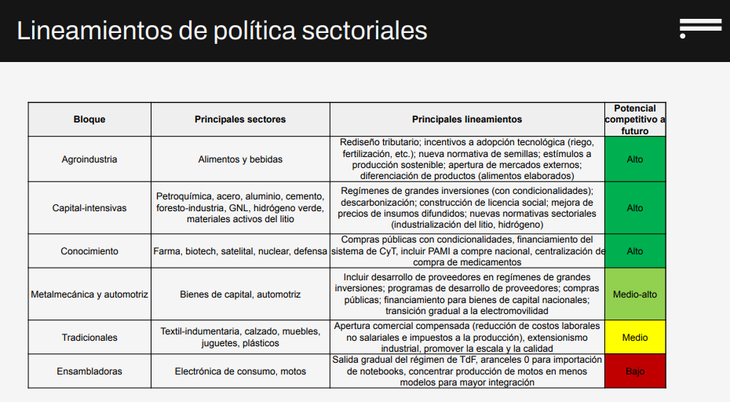While the Government of Javier Milei despises the manufacturing industry, which it considers inefficient and obsolete, the evidence reflects that industrial policy is growing exponentially at a global level. In that framework, Productive development specialists highlighted the need to implement in Argentina a battery of measures favorable to sectors with better future prospects, instead of continuing to promote activities that have already proven to have poor results. in socio-economic terms.
Industrial policy world.PNG
This week, the public policy research and design center Found public “Industrial policy in the 21st century”a series of three documents aimed at developing a diagnosis and a roadmap for the development of the Argentine industry. “lThe industry is a sector with indicators above the average of the economy, in the world and at a local level. “We believe that it has to play an important role in development, and that productive policies are required to realize its full potential,” Daniel Schteingart stated in dialogue with Ambito and other mediadirector of Fundar’s Productive Planning area, and one of the authors of the reports.
In this sense, the organization identified four industrial blocks with “high” or “medium-high” competitive potential: agribusiness, capital-intensive industries, the knowledge industry and the automotive/metalworking sectors. Meanwhile, he described the potential of traditional sectors as “medium” and the contribution of assembly industries as “low.”
Sectoral guidelines.PNG

The four industrial blocks that can be an engine of development in Argentina
Inside the agribusinessthe food and beverage division is the one that can drive development according to reports. This sector enjoys a wide range of attractions since it is the one that makes the most significant contribution to the industrial Gross Domestic Product (GDP) and the generation of foreign exchange in the manufacturing sector, as well as it stands out for the number of jobs generated, local integration of its production and its contribution to federal development. Its main disadvantages are the low innovation that occurs within the sector and the relative low rate of formality in employment.
On the side of the capital intensive industriesthe sectors with a better outlook are petrochemicals, steel, aluminum, cement, forestry-industry and activities linked to energy generation such as Liquefied Natural Gas (LNG), green hydrogen and the manufacture of active materials for adding value to lithium extraction. Among the advantages of these sectors, their contribution to GDP and the quality of employment in terms of rights and salaries stand out, with the negative trade balance being their weakest point at the moment.
As for the knowledge economythriving activities such as pharmaceuticals, biotechnology, and the satellite, nuclear and defense industries appear. This is the industrial sector with the best indicators in terms of quality of employment and salaries, and innovation, while its local integration is also worth highlighting. The small number of jobs created is its flattest variable.
Meanwhile, the metalworking and automotive sector can exhibit contribution to GDP, employment (both in quantitative and qualitative terms) and research and development (R&D) activities. As a negative factor, a strong trade deficit appears, the highest of the blocks in question.
For these sectors, the policies recommended in the documents are tailored to the particularities of each sector. Some examples are:
- Reduction in the medium term of withholdings to agroindustrial products with greater added value, in exchange for higher taxes on individual profits and estates
- An investment promotion regime for capital-intensive or metal-mechanical-automotive industries, with some elements of the current RIGI but with a greater promotion of the development of national suppliersand More limited time periods for tax benefits
- Public procurement policies for the knowledge sectoraimed at innovative products, to soften the risk involved in investing in this type of activity
A policy for the textile industry and traditional sectors
Regarding the traditional sectorswhich include the textile and clothing industry, and the production of furniture, toys and plastics, Some measures were suggested aimed at improving productivity, mechanization, design and quality.fundamental factors to formalize and improve working conditions.
“The technologically mature character and the severe competition against low-wage countries such as the Asian ones mean that this sector will not be the main lever of industrial development in the future. However, that does not mean that the bloc does not have potential and that it should be abandoned. to their own fate,” said one of Fundar’s documents regarding this sector, which It is the most important in terms of job creation (and with the highest rate of women), although it has deficiencies in terms of its quality and low innovative and export potential.
When asked by Ámbito about this sector, Schteingart explained that “Trade opening is necessary to stimulate competition and be able to generate products differentiated by quality and design, but it needs to be accompanied by compensation due to the negative effects that it can generate in some segments”.
Industrial blocks.PNG

The Tierra del Fuego regime, in the eye of the storm
Finally, the reports were extremely critical of the assembly sector, particularly with the Tierra del Fuego regime. According to reported statistics, This item is the one with the lowest contribution to GDP and employment, and the one with the worst indicator in terms of exports/sales. Furthermore, it has very low national integrationstanding out only for its high rate of formality in jobs.
For these activities The gradual exit of the Tierra del Fuego regime was proposed, 0 tariffs for the import of notebooks and the concentration of motorcycle production in fewer models for greater integration.
Fundar pointed out that the recent history of industrial policy in Argentina has left as many cases of success as of failure. Among the first, the consolidation of the biotechnological pole and the largest pickup hub in the regionas well as the fact of being the the only Latin American country to export geostationary communications satellites, radars or nuclear reactors research.
Among the latter, the main example was the “Fuegian assembly, which implied a higher fiscal expenditure than that carried out based on science and technology”, and the “excessive protectionism for low-productivity industries, at the cost of notable price premiums for consumers”.
In conclusion, the research center noted that “You don’t have to be afraid to choose winners”. “Just as companies have a portfolio of projects with different levels of success, States must do the same and choose strategic industries. It is key to know how to let go when one of those bets does not go well“, he deepened.
In parallel, he maintained that “Industrial policy must be much more offensive than defensive“, which implies the promotion of exports, investment in R&D and improvement of productivity.
Source: Ambito
I am Pierce Boyd, a driven and ambitious professional working in the news industry. I have been writing for 24 Hours Worlds for over five years, specializing in sports section coverage. During my tenure at the publication, I have built an impressive portfolio of articles that has earned me a reputation as an experienced journalist and content creator.




